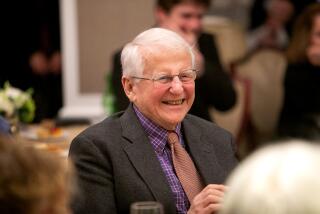Married With Children
Only John Updike could turn Hamlet’s melancholy metaphysics into a saga of love and betrayal in the suburbs. There are moments when “Gertrude and Claudius,” a prequel to Shakespeare’s “Hamlet,” is strikingly reminiscent of “Couples,” Updike’s examination of marital infidelity in the suburbs in the early 1960s. Despite the jangle of the warriors’ chain mail, the icy drafts whistling through the royal castle at Elsinore and the drunken excesses of the mead hall, this adulterous romance between Hamlet’s mother and her husband’s brother could just as easily have taken place on a king-sized bed at the Holiday Inn.
One might summarize the circumstances thus: Locked in a marriage with a man she respects but does not love, she discovers passion in her late middle age with her brother-in-law (recently returned from extended travels abroad). There are the familiar hesitations: His guilt over the betrayal of a brother he both loathes and admires, her remorse over the effect her affair will have on her troubled son. But they eventually overcome those scruples when they find themselves alone in the vacation house of a trusted friend.
There must have been moments when the author worried about these parallels. How else can one explain the novel’s periodic and rather awkward swerves in the opposite direction, toward the fusty cliches of Renaissance drama, the lofty pronouncements, the tired metaphors and labored conceits? Meanwhile, the intellectual milieu that stands behind Shakespeare’s great play is rehearsed so artlessly that it seems as if Updike cribbed his understanding of it from a textbook on Renaissance humanism.
Only rarely does Updike allow himself to become caught up in the texture of the world he is describing and, to be fair, when he does--as in his account of the lost art of falconry--the effect is dazzling. Of course, such digressions into the texture and detail of a world that is not our own are precisely what one wants from fictions like these. For an author who has made the realist novel his forte, his restraint is hard to explain.
In the end, what makes “Gertrude and Claudius” worth reading (or not) is its relationship to its source. Much of our interest in the novel depends on the extent to which it allows us to read Shakespeare’s much-beloved masterpiece afresh. In this respect, Updike can claim some success. In his hands both Gertrude and Claudius become much more complex and sympathetic figures, their motivations clearer, their illicit love blessed by their passion. Even the murder of Hamlet’s father becomes explicable as the only conceivable outcome to an otherwise desperate situation.
And if this is true, then Updike may be right to wonder out loud, as he does in his afterword, about Hamlet’s “impenetrable self-centeredness” which prevents him from extending his sympathy to those who need him most. If Updike is right, then Hamlet’s lack of sympathy is a failure of the imagination, an inability “to feel,” as King Lear ultimately learns through a painful process of humiliation, “what wretches feel.” (It may seem odd to accuse Hamlet of a failure of the imagination. After all, Hamlet’s tortured imagination has made him perhaps the most famous figure in all of literature. But that is, at least by implication, what Updike does.)
In the end, Hamlet’s intense desire to believe himself unique and isolated has made him unable to comprehend human frailty and the errors to which flesh is prone--a lack of comprehension that ultimately leads to the destruction of both Ophelia and his mother. If Updike’s “Gertrude and Claudius” could sustain this line of reading, it might be a better book. But Updike perversely saves his most intriguing assessment of Hamlet for the afterword and never fully incorporates its implications into the story he is telling.
“Gertrude and Claudius” is perhaps best understood as part of a long tradition of novels and plays based on characters or undeveloped plot lines from classic texts: among the most recent, John Gardner’s “Grendel” (“Beowulf”), J.M. Coetzee’s “Foe” (“Robinson Crusoe”), Jean Rhys’ “Wide Sargasso Sea” (“Jane Eyre”), Michael Cunningham’s “The Hours” (“Mrs. Dalloway”) and, of course, Tom Stoppard’s “Rosencrantz and Guildenstern Are Dead” (“Hamlet”). The purposes of these derivative works are varied: They may seek to do no more than lend dimension to an overlooked corner of the story or they may seek to do nothing less than rewrite the literary and historical record from the perspective of those who found themselves dispossessed by the original narrative.
If Updike’s achievement falls short of, say, Coetzee’s or Gardner’s, it may be because he has managed to take on Shakespeare’s great play without engaging its great themes. Writing a book that insinuates itself into “Hamlet” is a tall order, and it is by no means clear how that can be successfully done. T.S. Eliot once described “Hamlet,” not altogether approvingly, as the “Mona Lisa of literature.” It is hard to know what one can add to the “perfection” of “Hamlet” or to the Mona Lisa. It may be that Updike would have been better off to subtract from it.
That sounds like an odd way of putting it, but consider this: Marcel Duchamp deliberately subtracted from the Mona Lisa by giving her a mustache. As revisionary acts go, this doesn’t appear like much. But hidden in that simple gesture was a manifesto of sorts that not only liberated the artist from a constricting reverence for her but also raised questions about the status of art itself.
*
In literature one finds an analogous act of subtraction in Stoppard’s “Rosencrantz and Guildenstern Are Dead.” Stoppard’s play is essentially a burlesque of Shakespeare’s great tragedy. Indeed, the dialogue between Rosencrantz and Guildenstern sounds very much like the old Abbott and Costello routine “Who’s on First?” With this difference: The routine never ends. The effect is madness. But, to paraphrase Shakespeare, there’s method in it. What Stoppard has done is take Hamlet’s “madness” and transform it into the world his characters inhabit. Stoppard asks us to bumble along with Rosencrantz and Guildenstern in their clownish, albeit genuine, efforts to make sense of a universe that seems to operate according to no discernible laws. What makes Stoppard’s play superior to Updike’s novel is precisely this clowning around, which illuminates Hamlet’s most vexing and enduring questions in ways that Updike’s more serious approach fails to do. Somehow, in making light of “Hamlet,” Stoppard has managed to give it the weight it deserves.
It has been 10 years since Updike completed “Rabbit at Rest,” the last installment of a quartet of Rabbit books that appeared at the beginning of each decade starting in 1960. With Rabbit Angstrom safely retired in Florida, it may be that Updike feels he has exhausted that terrain. That does not mean, however, that his readers shouldn’t be permitted to feel a twinge of nostalgia for a world he managed to evoke with such breathtaking clarity. It is unreasonable to insist that an author stick with the milieu that has made him justifiably famous.
Writers should be applauded for taking risks, even when they fail. But the quality of Updike’s mind, his deliberately prosaic style--which is ideally suited to the peculiar rhythms of the American suburb--is so remote from the “Jutish gloom” of “Hamlet” that one wonders why he chose to take it on in the first place.
Despite the daily humiliations that Updike’s suburban characters experience, their petty evasions, illicit passions and, yes, the small joys they discover in places like Tarbox, Mass., or Mount Judge, Penn., there is a dimension to their lives that is truly Shakespearean. After all, Rabbit Angstrom (Updike’s most fully realized character and his greatest achievement) shares more than just Hamlet’s “self-centeredness.” It is not too farfetched to say that what Hamlet and Rabbit Angstrom ultimately share is a yearning for something--anything--that might throw the “slings and arrows of outrageous fortune” into meaningful relief.
In response to the Rev. Eccles’ questions about why he has left his wife, Rabbit says, “I told ja. There was this thing that wasn’t there.”
To which the good minister replies, “What thing? Have you ever seen it? Are you sure it exists?”
Instead of answering the minister’s heretical doubts about the absence of God’s grace in a fallen world, Rabbit steps up to his golf ball and swings:
“Very simply he brings the clubhead around his shoulder into it. The sound has a hollowness, a singleness he hasn’t heard before. His arms force his head up and his ball is hung way out, lunarly pale against the beautiful black blue of storm clouds. . . . Rabbit thinks it will die, but he’s fooled, for the ball makes its hesitation the ground of a final leap. . . . ‘That’s it!’ He cries . . . ‘That’s it.’ ”
In that one near-perfect swing--which no lessons or attention to mechanics can faithfully reproduce--Rabbit has caught sight of a grace that will elude him the rest of his life. Who is to say whose soul is more tortured: Rabbit’s or Hamlet’s? The man who has seen the form his redemption might take or the man who has not?
More to Read
The biggest entertainment stories
Get our big stories about Hollywood, film, television, music, arts, culture and more right in your inbox as soon as they publish.
You may occasionally receive promotional content from the Los Angeles Times.










